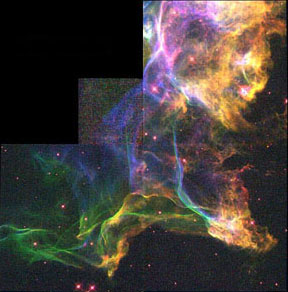Cygnus
The constellation of Cygnus, also known as the “Northern Cross” is headed up by Deneb, one of the “Summer Triangle” stars. Deneb is not as bright as Vega or Altair, the other members of the “Summer Triangle” and is one of the faintest of the twenty or so first magnitude stars. However, this is entirely due to its great distance from us, of about 1,500 light years. Deneb is in fact the most powerful first magnitude star, shining with the light of an incredible 80,000 Suns.
Cynus Loop (HST image)
Cygnus lies on one of the richest parts of the Milky Way and the region between Gamma and Beta is full of splendid star clouds. One of the most prominent Milky Way features in Cygnus however is an area devoid of stars. This is the “Great Rift”, a region of obscuring dust and gas starting in Cygnus and extending downwards towards the Galactic Centre in Sagittarius. Cygnus also contains several areas of nebulosity. One of the best known of these is the “North America” Nebula, so called because of its shape. This is an object which is very difficult to detect visually but which shows up very well on photographs. Another wonderful object is the “Veil” Nebula. This consists of the remnants of a supernova that exploded tens of thousands of years ago and which are now spread over an area of several degrees. Like the North America Nebula, the Veil is very difficult to detect visually with a telescope or binoculars. However using a suitable nebula filter brings it out beautifully. Other objects in Cygnus not to be missed include the “Blinking” Planetary (NGC 6826) and open clusters such as M29 & M39. Cygnus also contains some exotic objects beyond the scope of amateur instruments. Ninth magnitude Cygnus X-1 is one of the strongest X ray sources in the sky. It is thought that this is a binary system and that the radiation emanates from heated gas pulled from the visible star falling towards a massive invisible companion which is probably a black hole.
POWERPOINT SLIDE SHOW (398KB)